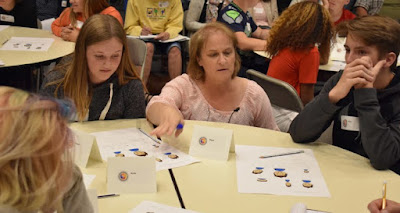Introductory Lesson on Fraction Concepts and Equivalence
January 11, 2017
Research Question:
What types of questions and patterns of questioning advance the level of classroom discourse?
With NCTM’s Principles to Actions, Ensuring Mathematical Success for All as the primary resource, this lesson study group set out to gain a deeper understanding of how different types of questions and patterns of questioning impact the level of meaningful discourse (NCTM, pp. 29-41). Through the lens of this lesson, the lesson study process illuminated many significant and practical insights in the ongoing quest to advance the level of meaningful discourse amongst students.
This group recognizes that all four types of questions are important (NCTM, pp. 36-37). However, it is important to decipher what classroom conditions and instructional goals are more fitting for different types of questions and patterns of questioning. The group has observed that the “Gathering Information” (Type 1) and “Probing Thinking” (Type 2) questions, are beneficial for providing feedback to the teacher as to what students’ current level of understanding is and can support the formation and wording of “Making the Mathematics Visible” (Type 3) questions and “Encouraging Reflection and Justification” (Type 4) questions to be asked in a focusing questioning pattern, which is more suitable to advancing the level of meaningful discourse involving important mathematical ideas and relationships. In contrast, attempting to use Type 1 and 2 questions to help students understand mathematical ideas would likely be associated with a less-preferred funneling pattern. Using a funneling pattern of questioning could be more appropriate in helping students to understand the context of the problem (what the problem is asking or clarifying what the task is), but not if it were to interfere with student inquiry into deepening mathematical understandings of important concepts that students should discover on their own. While types of questions and patterns of questioning are crucial, they are not the only instructional decision that impacts the level of meaningful discourse. Group dynamics, the structure of the lesson, having multiple entry points and the selection of the task will all impact the level of student discourse. It is also important to attend to which questions should be asked for students to talk about in small groups compared to those questions that are posed in a whole group setting.
There was clear evidence that the visual and concrete representations that students produce strongly support meaningful discourse amongst students, and significantly impacted the level of meaningful discourse in this lesson. In some cases, the visual representations prompted some students to ask questions of each other regarding the mathematical meanings and big ideas exhibited in those visual/concrete representations, indicating an advanced level of meaningful discourse from the Levels of Discourse table (NCTM, p 32).
This group also discussed explicit strategies for enhancing discourse that could include modeling effective conversation between the teacher and a student while the rest of the students observe, with a follow-up whole-class discussion about important elements of sharing mathematical ideas (eye-to-eye contact, listening to others’ ideas, asking clarification questions of each others’ ideas, etc). An additional idea discussed was the use of sentence frames to provide access to begin conversations.
Perhaps, however, one of the most important conclusions of this lesson study group has is a deepened understanding of, and belief in the power of the “5 Practices” model as an effective structure for promoting meaningful discourse and deeper mathematical understanding. Beyond the implementation of the “5 Practices” in the classroom, the group also believes that using this model as a tool for planning forced them to formally debate and decide upon questions that needed to be asked in different stages of the lesson that may not have been part of the planning discussion in some other model or framework. It was clear that using the 5 Practices for Orchestrating Productive Discussions naturally allows for more meaningful discourse. In this lesson, advanced levels of meaningful discourse were most visible when students were trying to connect different representations and ways of thinking. This model also lends itself to providing the opportunity for the teacher to ask more Type 3 and Type 4 questions. This group went as far as to question whether the “5 Practices” lesson structure had a greater impact on the level of discourse than the exact wording of the questions, question types and patterns of questioning. In particular, displaying students’ representations advanced the level of meaningful discourse and enhanced the quantity and quality of opportunities to use Type 3 and Type 4 questions in a focusing pattern. Additionally, because this structure allows for meaningful Type 3 questions, those same questions can pave the way for Type 4 questions. In other words, when asked to make the mathematics visible, students can then naturally be prompted to justify their reasoning when making connections among mathematical ideas and relationships, thereby advancing the level of discourse amongst students.










